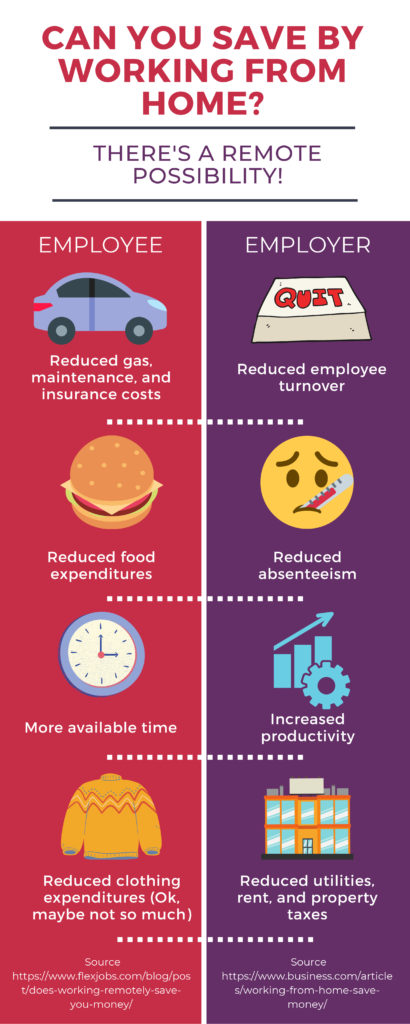10 Tips for Working Remotely [Infographic]

It has become a bit of a cliché to describe the year 2020 as unprecedented. 2020 has forced us as a company to adapt to new situations and overcome new obstacles. One area of dramatic change for many companies was moving to remote work. Thankfully though, we here at Demme Learning have some experience with remote work. In fact, even prior to the pandemic, many of our employees have worked remotely all over the country.
While there are obvious downsides to working remotely, there are some great opportunities and advantages as well. Check out this fun infographic on the cost benefits of remote work for employees and employers:

Whether you’ve always worked remotely or it has been thrust upon you, working from home in the age of coronavirus can take its toll. Now more than ever it is important to find the things that can help you both be your best and deliver your best. Keep in mind that it is not one-size-fits all. What works for me might not work for you. However, it is important that you invest the time and energy into figuring out what does in fact work for you. You are too important not to do it!
10 Tips for Working Remotely
1) Establish a Morning Routine
For many people, establishing a morning routine is essential to clearly defining work and non-work hours. That may mean doing everything exactly how you would if you were going to the office. Some people even go so far as to go to their car and drive around the block (or make their normal morning coffee run)! For others, it may mean using that previous commute time for a morning exercise session or prayer and meditation. Whatever you choose, try to get in the habit of getting up at the same time and doing it consistently. This will also help make any transition back to the office smoother as well.
2) Establish an End-of-Day Routine
Set a reminder 10 or 15 minutes before the end of work to close out projects, send final emails, check tomorrow’s calendar–whatever it is you need to wrap up. Shut the computer off or put that pen down. Finally, establish some post-work ritual. Maybe it is shouting, “Woo hoo!” Maybe it’s slamming your office door. Maybe it is voicing a quick prayer of thanks for a productive day and blessings for a relaxing evening. Maybe it is singing “Taps.” If your workspace is in a shared living space, maybe it is changing the lighting or closing a window blind. Whatever you choose, it is important to give your brain a clear and consistent signal that you are moving from work/office life to home life.
3) Play Uplifting Music
If you are able and it isn’t distracting, play some uplifting music while you work. If you can’t, consider enjoying a mini concert before work or a single song dance break during the day.
4) Consider Having a Designated Workspace
If you have the luxury of a room reserved to use as an office, that can make it easier to “turn off” and separate work life from home life. If not, even
having the same area (a certain end of the dining room table, a small desk in a corner of a bedroom) can be helpful. It can also allow you to be more productive and focused during work hours.
5) Think About Ergonomics & Distrcations
For some people, a constant change of environment is going to lead to better productivity as well as physical and mental health. Just ensure that all of your chosen locations throughout the day provide proper ergonomics and aren’t full of overly enticing distractions. I personally do best sticking mainly to my dedicated office space but will often walk around the house during off- camera meetings or calls.
6) Use Your Calendar
Your work calendar isn’t just for meetings! Consider blocking out time on your calendar to work on projects. Once you block out time, barring emergencies, stick to it! Try to avoid checking email or engaging in chats turning the designated block. (Preaching to myself here…)
7) Take Your Breaks!
(Again, pointing my finger at myself.) In addition to making sure you are
getting up and moving at least once an hour (Love those reminders from my watch!), be sure you are taking a full lunch break. Even if you don’t eat, get some fresh air, take care of a chore that will make your evening more relaxing, call a friend . . . I’ve definitely noticed when I take that time for myself, I’m able to give more focus to both my work and my family (and with a better attitude too).
8) Turn Your Camera On!
A phenomenon I’ve noticed since we’ve moved to most of the company
working remotely is that fewer people are turning on their cameras. Now more than ever we need to connect with each other. Staying behind the “shield” of the computer screen could also lead to online disinhibition effect and responding to others in a manner we would not do in person. While bandwidth may be an issue during large meetings, consider turning the camera on during meetings and using a video chat rather than text chat to connect with colleagues when you can.
9) Think About The Benefits
What’s the best thing about working from home for you and your family? Is there a way you can capitalize on that? Perhaps you are saving money on childcare or transportation costs. You might find some fun goal to put those funds towards and think about it when you’re having a rough remote day.
10) Don’t Expect It To Be Perfect!
It is going to take trial and error to find the best work-at-home arrangement for you. Kids are going to interrupt in the middle of an important meeting. Family members are going to not understand that you are actually working when you are home, and you can’t just drop everything. The neighbor’s hunting dog is going to corner a squirrel outside your office window while you’re trying to record a training video. (Oh, that’s just me, huh?) Give yourself some grace, and realize that everyone is dealing with these obstacles too. We’re in this together.
What keeps you productive and sane while working remotely? Share your tips and experiences in the comments section below!